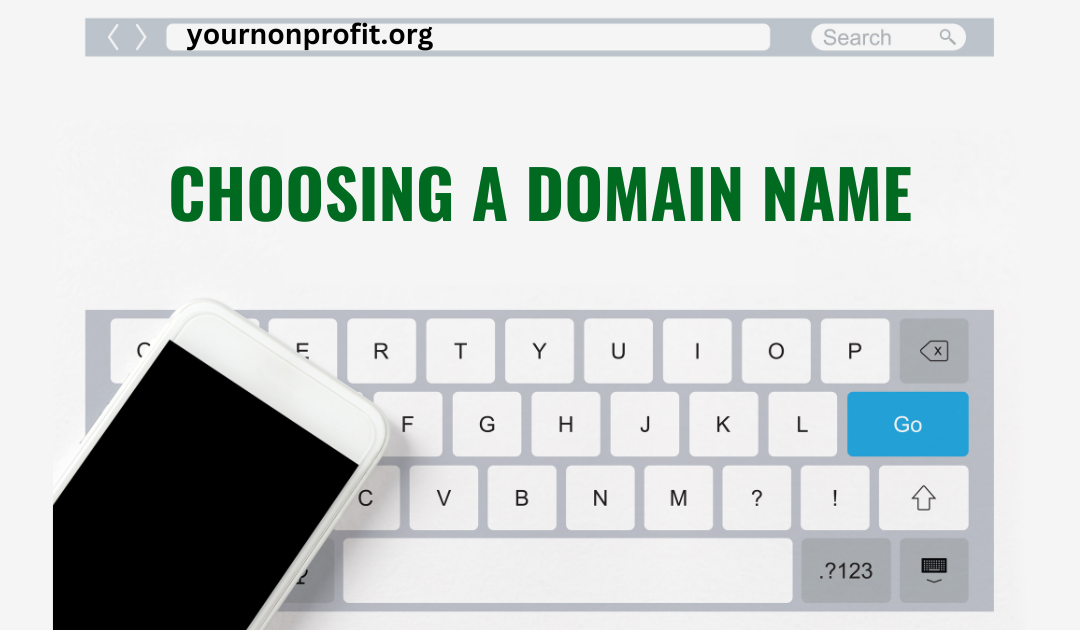Your domain name is more than just a web address—it’s the first thing people notice about your nonprofit online. It sets the tone for how others perceive your mission, and in a crowded digital space, it can make or break your visibility.
Sometimes choosing a domain is easy. You might find your nonprofit’s name with “.org” available and are likely good to go. But with hundreds of millions of domain names already registered, it can be difficult to find the right one.
This article covers top-notch tools and six essential tips to make choosing the right domain name much, much easier.
What Is A Domain Name Anyway?
A domain name is essentially the web address for your site—it’s what people type into their browser’s URL bar to find you online. For example, “treerootsnonprofits.com” is the domain name for this website.
Domain names aren’t case-sensitive, so whether someone types TREErootsnonprofits.com or treerootsnonprofits.com, they’ll still end up in the same place.
While you can technically change your domain name later, it’s not an easy process and often causes more hassle than it’s worth. Generally, it’s better to choose a solid domain name from the start and stick with it as your site grows.
In other words, you want to get it right the first time.
Here are the 6 tips to do just that:
1. Think First and Foremost About Using “.org”
Your top-level domain (TLD) is what comes after the dot. In “treerootsnonprofits.com,” for example, the TLD is “.com.” While “.com” is by far the most popular and worth considering, as a nonprofit, you’ll likely want to go with “.org,” which stands for “organization.”
Since there are many more “.com” domains already taken, you’ll likely have more options with “.org.” Plus, “.org” immediately signals to visitors that you’re a nonprofit. If you’re based outside the US, it’s also worth considering your country’s specific TLD (for example, “.co.uk” for the UK). If you’re an educational institution in the US, “.edu” may be more appropriate, but for most nonprofits, “.org” is the best choice.
You can explore options like “.com,” “.net,” or even newer domains like “.io” (especially for tech-focused nonprofits) if your preferred “.org” is taken. However, if “.org” is unavailable, it’s usually better to brainstorm a new domain name to avoid confusion.
In summary, “.org” is your safest bet. It’s widely associated with nonprofits and carries a certain level of automatic trust. As a nonprofit launching a new website, building trust from the outset is crucial.
It’s highly recommended to choose “.org” over “.us” if you’re in the United States. However, if you want to signal your country of origin, you might also consider a country-specific TLD like “.ca” for Canada or “.co.uk” if you’re in the U.K.
2. A Shorter Domain Name Is Better
Keep it to 6-14 characters if possible. Many shorter domain names have already been taken. Some are being used, while others might be held hostage to be sold for hundreds or even thousands of dollars. Still, try to keep it short if you can!
3. Think About Search Engine Optimization

Keywords in your domain can boost your search engine ranking. For example, choosing “treerootsnonprofits.com” over “treerootsnpo.com” was a strategic decision for SEO. While “treerootsnpo” is shorter, having the full word “nonprofit” in the domain increases the chances of showing up when people search for terms like “nonprofit.”
If someone is looking for nonprofit website help or nonprofit fundraising ideas, “treerootsnonprofits” is more likely to appear in search results. When selecting your domain, think about the words people are actually searching for, rather than internal jargon.
That said, your domain name doesn’t need to be completely optimized for search engines—there are much more important factors to consider. So, don’t make your decision with SEO at the forefront, especially if you’re not already familiar with SEO. However, it still can worth factoring in, as a well-chosen domain can give you a slight SEO edge. You can also think through how to avoid these SEO mistakes as a nonprofit.
4. Make Your Domain Name Memorable
Your domain name is a prime opportunity for branding, but it also needs to be practical for the thousands of people who will (hopefully) be typing it in regularly. You can check out this article on how to drive traffic to your nonprofit’s website. You want it to be as easy as possible for them to remember and type. For example, “treerootsnpo” might be short, but “nonprofits” is much easier to associate with charities, especially in countries where “NGO” is a more common term.
Once you’ve narrowed down your domain choices, try a simple test: share your potential domain with a few people and ask them to spell it out. If more than a few struggle, it might be a sign to simplify the name.
While ease of spelling is important, it’s also helpful if the domain is easy to pronounce. Try spelling it for a few different people and see how they say it out loud.
One final tip here—avoid using hyphens or numbers in your domain name if you can. They tend to confuse people and make your domain harder to remember.
5. Brainstorm Domain Name Ideas

The only tools you should use first are a pen and paper (or a Google doc). Brainstorm at least 10 potential domain names. Jot down words that are meaningful to your nonprofit or related to your mission. Once you have this list, it will serve as a foundation when you start using domain name tools to generate more ideas or check availability.
6. Use Tools To Help
And now, the tools. Once you and your team have finished brainstorming, and you have a list of ideas, you can start using tools to check availability and generate more options if needed.
To check if your preferred domain is available, here are two essential tools (with a few others to consider below):
- Make sure it’s not trademarked. This is something you probably already did while naming your nonprofit if your website relates to your name, but you can do this quickly by going to trademarks.justicia.
- Use Namechk – this not only gives you an idea of the domain names taken but also what’s available on social media sites.
If you’re set on a “.org” name but see other domain names taken, check out those sites. See if it’s related to your nonprofit. Also, try searching for it in a few different ones on Google and see if it comes up. You could plug it into a tool like spyfu or ubersuggest to see if it has a high amount of traffic and it ranks pretty well. If it does, then people might have trouble finding your site by searching Google. While this shouldn’t necessarily stop you from choosing a domain, it’s something to consider if people might struggle to find your site.
You might also discover that the “.com” version of your desired domain isn’t available, or that the “.net” is in use. This might be okay. If those domains are registered but unused, you won’t be competing with them in search rankings anytime soon.
Try searching for your domain broken into words. For example when you google “treeroots nonprofits” separated, this website comes up.
One more thing: you might find that the domain is marked as premium, meaning it’s already owned and being sold for a higher price. Sometimes the price is listed, and you can buy it outright. You could also reach out to negotiate. While it’s difficult to change domains later, this could be an option if it’s too expensive now. However, if you’re just launching a nonprofit site, it’s generally not worth spending more than a few hundred dollars on a domain until you’ve built some traction.
To get more ideas, use these 2 tools:

First off, use leandomainsearch.
Simply enter a few keywords—perhaps from your brainstorming list—and it will generate a list of available “.com” domain names. Keep in mind, this tool only searches for “.com” domains, so you’ll need to double-check if “.org” is available separately. This is especially helpful if you have a domain in mind but need to add a short word or two to make it available. By adding a small prefix or suffix, you may find a domain that works for your nonprofit.
Something that offers more bells and whistles is bustaname. In addition to checking domain availability, it lets you combine different words and phrases to help you find a suitable name. You can also save domains you like for future consideration. While it won’t generate entirely new ideas, it’s a powerful tool for mixing and matching words to create the perfect domain.
If you still haven’t settled on a nonprofit name, a tool like Shopify’s Business Name Generator is a great place to start. They offer more creative suggestions, helping you come up with unique names before you dive into domain searches.
Choosing A Nonprofit Domain Name Conclusion
Choosing a domain name can take a bit of thought but it doesn’t need to be a chore. It’s the exciting first step for your website. First, see if your nonprofit’s name or a shortened version of it is available. If not, let those creative juices flow. Spend a few minutes checking what’s available, get a few outside opinions and you should be able to narrow in on a winner.
If you want an expert to weigh in, feel free to get in touch with me at jordan@treerootsnonprofits.com.

